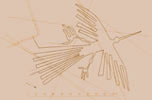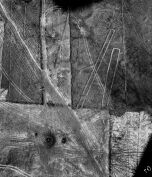1926
The Peruvian archaeologist Mejia Xesspe discovers the geoglyphs.
Thirteen years later he publishes his theories, which say that the lines
could be religious-ceremonial streets.
1941
The American culture historian Paul Kossok does the first fieldwork
and takes several hundred aerial photos. On June 22nd, the winter solstice,
he observes a long line in the Pampa, which goes nearly exact in the direction
of the sunset. He comes to the conclusion that the lines have an astronomical
meaning and calls the plateau “The greatest astronomical book of the world”.
1946
Maria Reiche starts her work at the plateau at the request of Kossok.
She is also convinced of the astronomical background and believes to see a huge
calendar installation. This would be matching with Spanish chronicles of the 16th
century according to the Peruvian must be in the possession of a calendar, which
is created on exact sky observations.
1969
In a limited area of the Pampa the American astronomer Gerald Hawkins utilizes
measurements with a theodolite with the help of mathematical statistics.
Because of his results he rejects the thesis of the calendar.
Beginning of the ‘80s
Aveni and Urton carry out statistical investigation in the Pampa de Nazca
on a higher level then Hawkins and they come to the end that the astronomy had
played also a roll at the creation of the lines.
1994
The association “Dr. Maria Reiche – Linien und Figuren der Nazca-Kultur in Peru”
is established in Dresden and a little bit later the research project “Nazca” of the
University of Applied Sciences Dresden is found with the target to continue the research
of Maria Reiche and to keep her legacy.
|


